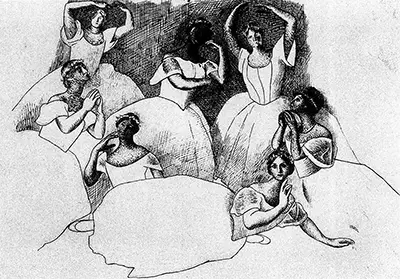Picasso is best known for his colorful modern art scenes of people with distorted features. Seven Ballerinas II is different. Not only is this artwork not a painting but a pencil drawing on paper, but the women depicted in the scene look fairly normal. Only their arms and hands are oversized. The style of the painting is neoclassicism from the cubist period. The drawing was created in 1919 and measures 50 x 62,2 cm. The original work can be found in Musee Picasso in Paris, France. As the name implies, the drawing shows seven ballerinas. Two are holding a fifth position ballet pose, two are kneeling while gazing adoringly at what appears to be the prima ballerina, while the remaining two are in a semi-resting position.
All seven ballerinas wear romantic length tutus with a tight bodice, capped sleeves and a full skirt. They wear makeup and their hair is worn pinned up and decorated with a chain of flowers. None of the ballerinas are wearing jewelry, except for one who is wearing a close to the throat necklace. Judging by the pose of the ballerinas, the drawing could either be the final scene of a dress rehearsal or a stage performance.
By comparison, the ballerina scenes that Edgar Degas drew or painted are far more realistic. The dancers are slender, with serene features, proportional limbs and true to life ballet outfits. Degas’ works feature either a single ballerina, duos, trios or groups. The dancers are portrayed practicing at the bar, rehearsing in class, dressing, getting ready for a performance or in performance on stage. In the end, it’s really whether the buyer prefers modern art or realism. In a modern home, a Picasso drawing or painting will be better suited, while in a rustic or contemporary home, a Degas work will be more appropriate.

